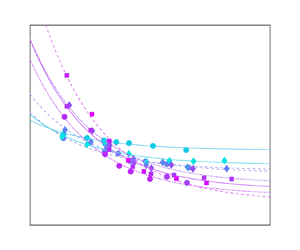No CrossRef data available.
Article contents
Non-universality and dissipative anomaly in compressible magnetohydrodynamic turbulence
Published online by Cambridge University Press: 27 August 2024
Abstract

We systematically study the dissipative anomaly in compressible magnetohydrodynamic (MHD) turbulence using direct numerical simulations, and show that the total dissipation remains finite as viscosity diminishes. The dimensionless dissipation rate  $\mathcal {C}_{\varepsilon }$ fits well with the model
$\mathcal {C}_{\varepsilon }$ fits well with the model  $\mathcal {C}_{\varepsilon } = \mathcal {C}_{\varepsilon,\infty } + \mathcal {D}/R_L^-$ for all levels of flow compressibility considered here, where
$\mathcal {C}_{\varepsilon } = \mathcal {C}_{\varepsilon,\infty } + \mathcal {D}/R_L^-$ for all levels of flow compressibility considered here, where  $R_L^-$ is the generalized large-scale Reynolds number. The asymptotic value
$R_L^-$ is the generalized large-scale Reynolds number. The asymptotic value  $\mathcal {C}_{\varepsilon,\infty }$ describes the total energy transfer flux, and decreases with increase of the flow compressibility, indicating non-universality of the dimensionless dissipation rate in compressible MHD turbulence. After introducing an empirically modified dissipation rate, the data from compressible cases collapse to a form similar to the incompressible MHD case depending only on the modified Reynolds number.
$\mathcal {C}_{\varepsilon,\infty }$ describes the total energy transfer flux, and decreases with increase of the flow compressibility, indicating non-universality of the dimensionless dissipation rate in compressible MHD turbulence. After introducing an empirically modified dissipation rate, the data from compressible cases collapse to a form similar to the incompressible MHD case depending only on the modified Reynolds number.
- Type
- JFM Papers
- Information
- Copyright
- © The Author(s), 2024. Published by Cambridge University Press



